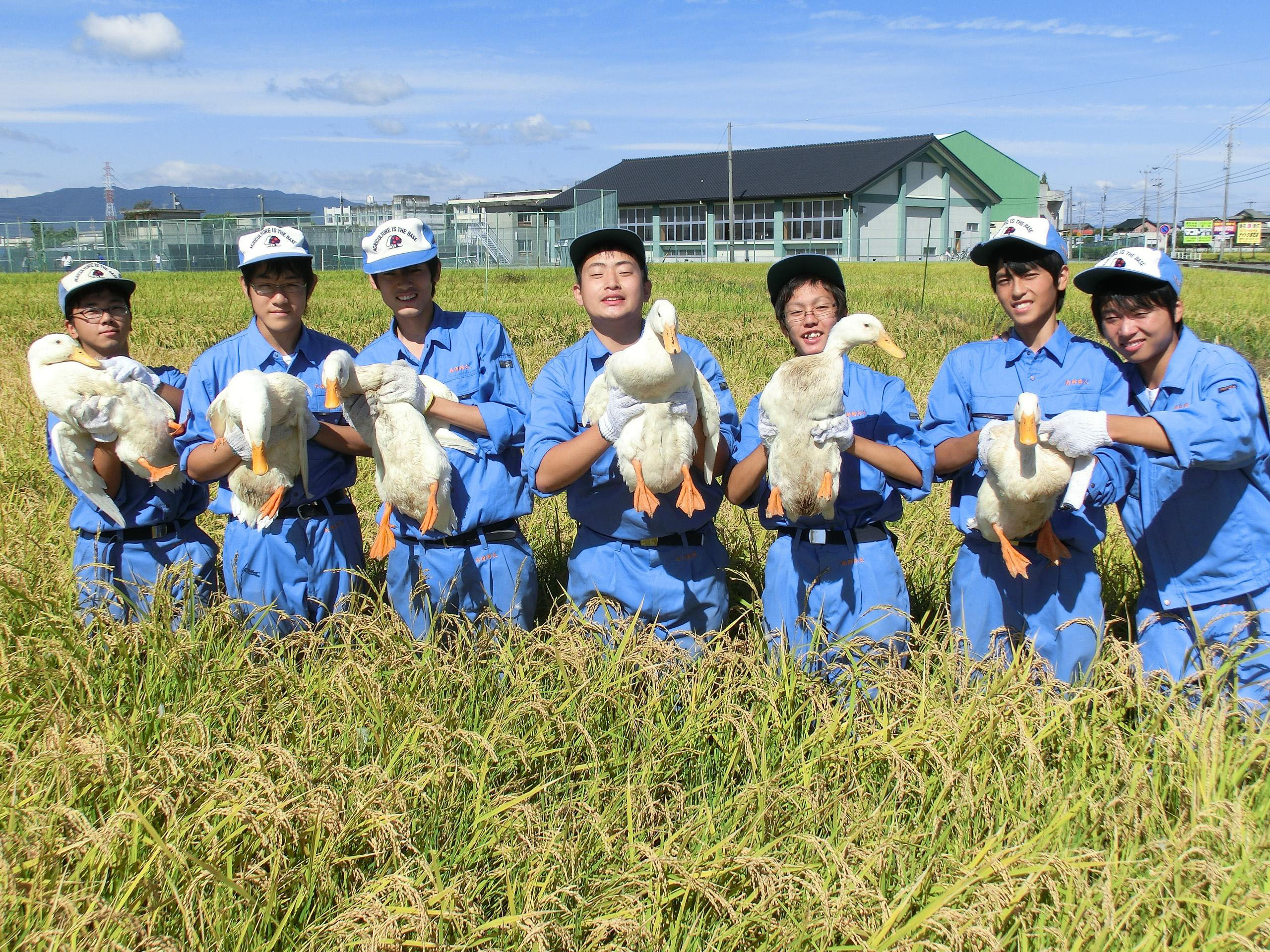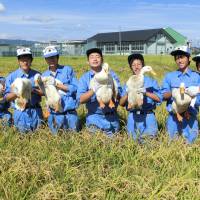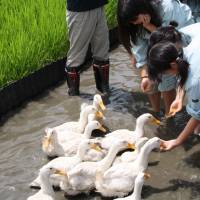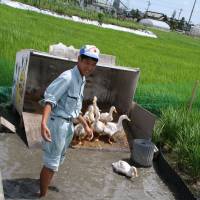In mid-July, together with a couple of celebrities, a reporter and some staff from Aeon Co., Ltd., Asia's biggest retailer, I took a half-hour bus ride from Nagoya Station to the city of Aisai in Aichi Prefecture to visit Saya High School there.
The school's curriculum emphasizes agriculture, and last year its students won the Prime Minister's Award, which is sponsored through the One Percent Club, a scheme that takes 1 percent of the selling price of various Aeon products and goods and deposits the money into a fund to support and encourage environmental programs. I am a committee member.
Saya High School was the first to win this Prime Minister's Prize — for its 11-year-old program of raising ducks for its rice paddies.
This traditional way of keeping paddies free of pests takes time and care but produces excellent rice, in good yields, without the use of any pesticides.
The ducks eat all kinds of insects and aquatic insect larvae and, because they have serrated ridges along the edges of their bills that enable them to filter out water, they can eat even tiny mosquito larvae. Also, as they paddle around, the ducks stir up mud, preventing light from reaching the bottom. This curbs the growth of aquatic weeds between the rows of green growing rice stems — and what small weeds do manage to sprout soon get eaten.
Most domesticated ducks, with the exception of the Muskovy and a few other breeds, descend from wild mallards, and the small aigamo ducks in fairly widespread use on rice paddies in Japan are crossbred from mallards and domestic varieties. However, Saya High School's large white fowl with yellow bills and feet are, although very common in China and other Asian countries, unusual in Japan. Reaching up to 5 kg when fully grown, they too derive from mallards, though they flock more readily than aigamo and easily imprint with humans. In other words, they are very friendly and would eat from the students' hands.
When I was a boy growing up in Britain, Aylesbury ducks — named after the county town of Buckinghamshire, northwest of London — were the most common domestic variety, and since the 18th century that town has been famous for producing ducks for meat, eggs and their soft white downy feathers greatly valued for quilts.
At Saya High School, though, when I asked the teacher in charge, Hiroyuki Kamejima, what kind of duck theirs were, he didn't say Aylesbury — but "Pekin."
"I thought that was the name for a kind of Chinese food," I said — but I was wrong. Peking duck is the delicious plucked, gutted and roasted delicacy eaten with pancakes, but Pekin is the name of another mallard-derived breed of poultry that reached Britain and America from China in the late 19th century and which is now the most common domestic duck there is.
The school's rice paddies are planted with the help of local elementary school children, and the whole program has also welcomed students from abroad. The rice produced is richer in protein and minerals than most more expensive brand-name types. We tasted some excellent bread made from milled rice grains, as well as the white boiled rice, which was probably among the best I've tasted.
The ducks are bred at the school, though the eggs are put in incubators to hatch because this type of duck is not a very good brooder. They reach about 2½ kg in four months, and when they come to maturity and the females start laying they will produce an egg most days if they are not brooding. These school ducks each lay about 70 eggs in four months and the surplus ones are sold to specialty outlets.
Because no pesticides are used in the school's paddies, various aquatic creatures have returned. These include rare or endangered species such as the tiny killifish, which used to be common all over Japan but is now rarely seen, as well as the giant predatory tagame water beetle — which is easily able to catch and kill a frog — and the water mantis, which has the curious habit of breathing through a snorkel tube protruding from its bum. (I don't think that will ever be included in PADI diving programs!)
Various other water beetles, dragonfly larvae, loaches and edible pond snails are also found, not to mention the stately white egrets and the ducks' wild mallard relatives who come to visit and feed.
When we visited, the ducks were penned as the water had been temporarily drained from the paddies. This practice, called nakabōshi in Japanese, is to strengthen the roots of the rice plants. After a while without surface water, the paddies are flooded again and the eager ducks are reintroduced to their watery play and feeding grounds.
Later, when the rice grains begin to swell and ripen, the ducks will leave them alone as long as the stems are upright, but as soon as the seed heads start to bow, the ducks have to be penned again. Otherwise they would fatten themselves on rice.
The students and teachers don't have the heart to slaughter their ducks, and they don't keep that many, so they either give them away to nursery and primary schools, or keep them at the school to breed the next flock of paddy ducks.
Having lived with fields, woods and rice paddies around me for the last 33 years here in Kurohime in northern Nagano Prefecture, I am very aware of the damage done to surrounding nature by the pesticides and herbicides lavishly used on rice paddies.
The first couple of years I lived here, from June on for a couple of weeks there were always thousands of fireflies. Then they sprayed pesticides from a helicopter. We not only lost the fireflies around the paddies, but many other creatures too. Numbers of frogs, dragonflies, water beetles, pond snails and so on decreased dramatically. For the last 28 years at our Afan Woodland Trust, we have been doing our best to bring them back in the ponds and waterways we dug and in the streams we cleaned out.
But I'm not alone in recognizing the dangers of pesticides and herbicides. I actually know local farmers who reserve a paddy to provide rice for their own family consumption, using very little or no chemicals on it — though it's agribusiness as usual on paddies producing rice to sell.
Raising ducks is fun, but you have to look after them. Even though they eat wild food, they need to be fed with grains and other stuff when penned, and to encourage them to gather they are fed by hand when on the water. They should be put into safe houses or pens during the night.
The school loses about a third of its ducklings to sickness and to predation by crows and nutria, a large alien species of semi-aquatic rodent that was introduced from South America for its fur. If we tried to raise ducks on paddies around Kurohime, we would have to take extra care; we have foxes, martens, weasels, racoon dogs and various hawks and kites to contend with — not to mention deep winter snows. It could be done though, with thought and care.
Just watching ducks paddle, dabble, dip, waddle and quack brings a smile to most people's faces, and small children especially delight in them. Moreover, there's nothing like a boiled duck egg for breakfast.























With your current subscription plan you can comment on stories. However, before writing your first comment, please create a display name in the Profile section of your subscriber account page.